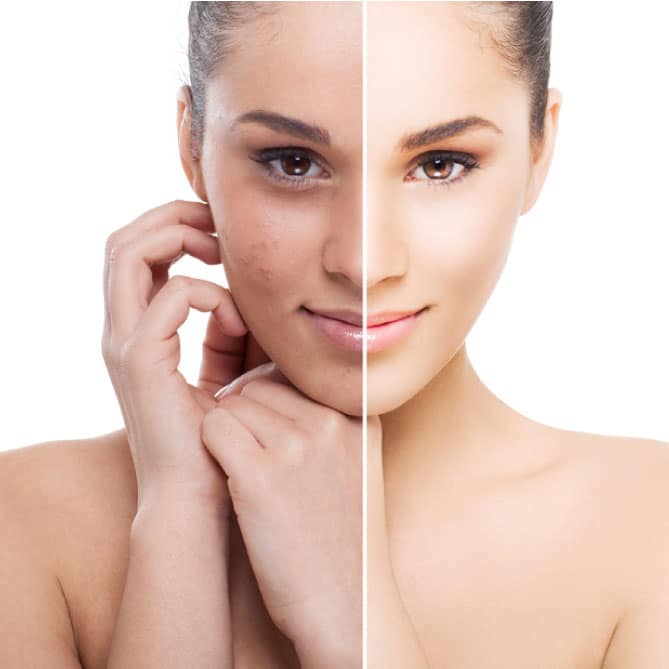Skin Tightening Treatments
Nonsurgical Skin Tightening
Also known as ultrasound skin tightening
Skin tightening procedures have become very popular in recent years because they provide a nonsurgical alternative to more invasive procedures for correcting skin laxity and improving skin quality. Today your plastic surgeon can choose among a number of different devices and technologies that provide noninvasive skin tightening solutions.
When to Consider Nonsurgical Skin Tightening
- If you have mild to moderate loose skin on your face, neck, arms or abdomen
- If you have residual skin laxity after an operative procedure
- If you would like an improvement in the quality of your skin
- If you are unable (or unwilling) to undergo a more invasive, surgical procedure to correct skin laxity
Considerations
Pros
- A noninvasive, nonsurgical technique that tightens facial or body skin
- Performed with no incisions, minimal discomfort and little to no downtime
- May be used for all skin types
Cons
- Results are less extensive and dramatic than those obtained with a facelift or body contouring procedures
- Multiple treatments are usually needed for optimal results
- Skin redness, temporary swelling or numbness or volume loss around the treated area may occur
These are the top three pros and cons to weigh when considering nonsurgical skin tightening. If you want to focus on what is unique to you, please consult with your aesthetic plastic surgeon.
Are you a good candidate for a nonsurgical skin tightening?
The following are some common reasons why you may want to consider nonsurgical skin tightening:
- You have mild to moderate loose skin on your face, neck, arms and abdomen
- You have residual skin laxity after an operative procedure
- You would like an improvement in the quality of your skin
- You are unable (or unwilling) to undergo a more invasive surgical procedure to correct skin laxity
Multiple treatments are usually required for maximum benefit.
Detailed Procedural Info
How is a nonsurgical skin tightening procedure performed?
Depending on your skin quality and the area being treated, your surgeon may choose one of the treatments described below. Before the procedure begins the area to be treated is cleaned of makeup and skin lotions. Some treatments require a thin coat of ultrasound gel during treatment. Oral or intravenous pain medication may be required depending upon device, treatment area, and your individual needs.
Radiofrequency
- The treatment area is measured and marked
- Your skin is cooled for comfort and safety
- A specially designed treatment tip is placed against your skin
- Radiofrequency energy penetrates deep into the skin’s tissue, heating the treatment areas and stimulating collagen production
- You will feel a gentle vibration as well as cooling and heating sensations during each pulse
- The upper layer of your skin is cooled
Intense pulsed light (IPL)
- If your face will be treated, you will be provided with protective eye covering
- A handpiece is used to administer a continuous cooling while an infrared light heats the deep dermis (deep layer of your skin)
- One or more passes may be performed
Ultrasound
- The treatment area is measured and marked
- An ultrasound gel is applied to your skin
- A smooth handpiece is placed on your skin and an image of the tissue beneath is projected on a screen so your surgeon can see the treatment area
- The ultrasound emits small thermal bursts to stimulate the deep structural support layers of the skin without disturbing the skin’s surface
What are my options?
There are three general options for nonsurgical skin tightening. After evaluating your skin quality and the area being treated, your plastic surgeon will choose the option that is best suited for your particular situation and will recommend an approach based upon your aesthetic goals.
Radiofrequency and intense pulsed light treatments heat only the deep layer of your skin. The epidermis or outer skin layer is not damaged. Your body’s natural wound healing response causes collagen changes in the skin which results in skin tightening. A series of treatments is usually performed.
Ultrasound treatments focus ultrasonic energy to the dermal layer (the deep layer of your skin). Your skin above the focus point and tissue below the focus point are protected. New collagen growth is stimulated, which gradually lifts and tightens the skin. Like radiofrequency and IPL, multiple treatments may be needed.
What are the brand names for nonsurgical skin tightening?
Radiofrequency
- Thermage
- Accent
- Pelleve
Intense Pulsed Light (IPL)
- Titan
- Sciton’s St
- VelaShape (combines radiofrequency and IPL)
Ultrasound
- Ultherapy
- VaserShape
Selecting a Surgeon
Select a surgeon you can trust
It’s important to choose your surgeon based on:
- Education, training and certification
- Experience with nonsurgical skin tightening
- Your comfort level with him or her
Members of the American Society for Aesthetic Plastic Surgery are experienced and qualified to perform your aesthetic procedure. Learn how to select a surgeon.
After finding a board-certified plastic surgeon in your area who is experienced in performing nonsurgical skin tightening, you will need to make an office appointment to set up your consultation. Generally, because of the in-depth nature of the consultation, there is a cost associated with the initial visit.
Your initial consultation appointment
During your initial consultation, you will have the opportunity to discuss your cosmetic goals. Your surgeon will evaluate you as a candidate for nonsurgical skin tightening and clarify what a nonsurgical skin tightening can do for you. Understanding your goals and medical condition, both alternative and additional treatments may be considered








No Comments